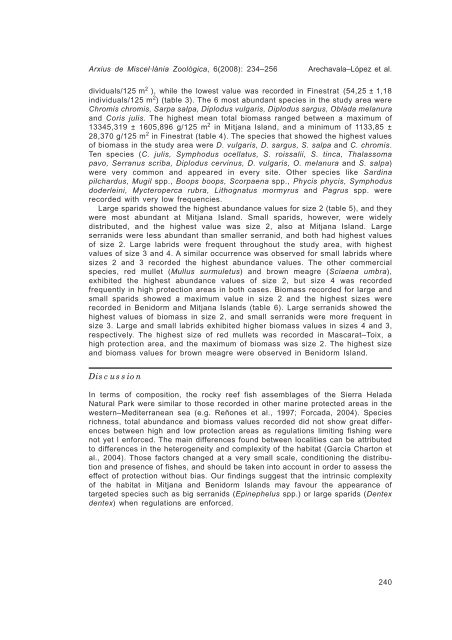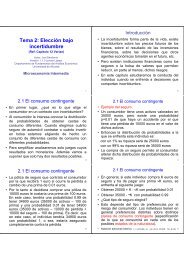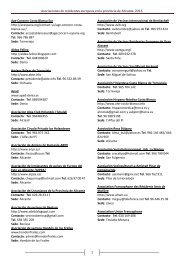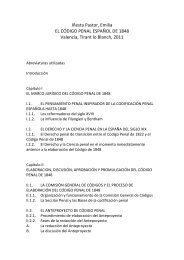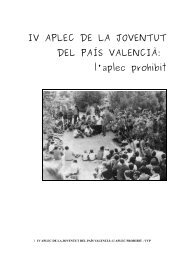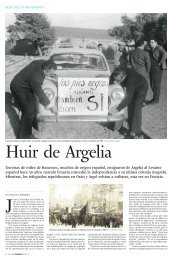Arechavala 2008 Rocky fish biodiversity sierra helada
Arechavala 2008 Rocky fish biodiversity sierra helada
Arechavala 2008 Rocky fish biodiversity sierra helada
Create successful ePaper yourself
Turn your PDF publications into a flip-book with our unique Google optimized e-Paper software.
Arxius de Miscel·lània Zoològica, 6(<strong>2008</strong>): 234–256<strong>Arechavala</strong>–López et al.dividuals/125 m 2 ), while the lowest value was recorded in Finestrat (54,25 ± 1,18individuals/125 m 2 ) (table 3). The 6 most abundant species in the study area wereChromis chromis, Sarpa salpa, Diplodus vulgaris, Diplodus sargus, Oblada melanuraand Coris julis. The highest mean total biomass ranged between a maximum of13345,319 ± 1605,896 g/125 m 2 in Mitjana Island, and a minimum of 1133,85 ±28,370 g/125 m 2 in Finestrat (table 4). The species that showed the highest valuesof biomass in the study area were D. vulgaris, D. sargus, S. salpa and C. chromis.Ten species (C. julis, Symphodus ocellatus, S. roissalii, S. tinca, Thalassomapavo, Serranus scriba, Diplodus cervinus, D. vulgaris, O. melanura and S. salpa)were very common and appeared in every site. Other species like Sardinapilchardus, Mugil spp., Boops boops, Scorpaena spp., Phycis phycis, Symphodusdoderleini, Mycteroperca rubra, Lithognatus mormyrus and Pagrus spp. wererecorded with very low frequencies.Large sparids showed the highest abundance values for size 2 (table 5), and theywere most abundant at Mitjana Island. Small sparids, however, were widelydistributed, and the highest value was size 2, also at Mitjana Island. Largeserranids were less abundant than smaller serranid, and both had highest valuesof size 2. Large labrids were frequent throughout the study area, with highestvalues of size 3 and 4. A similar occurrence was observed for small labrids wheresizes 2 and 3 recorded the highest abundance values. The other commercialspecies, red mullet (Mullus surmuletus) and brown meagre (Sciaena umbra),exhibited the highest abundance values of size 2, but size 4 was recordedfrequently in high protection areas in both cases. Biomass recorded for large andsmall sparids showed a maximum value in size 2 and the highest sizes wererecorded in Benidorm and Mitjana Islands (table 6). Large serranids showed thehighest values of biomass in size 2, and small serranids were more frequent insize 3. Large and small labrids exhibited higher biomass values in sizes 4 and 3,respectively. The highest size of red mullets was recorded in Mascarat–Toix, ahigh protection area, and the maximum of biomass was size 2. The highest sizeand biomass values for brown meagre were observed in Benidorm Island.DiscussionIn terms of composition, the rocky reef <strong>fish</strong> assemblages of the Sierra HeladaNatural Park were similar to those recorded in other marine protected areas in thewestern–Mediterranean sea (e.g. Reñones et al., 1997; Forcada, 2004). Speciesrichness, total abundance and biomass values recorded did not show great differencesbetween high and low protection areas as regulations limiting <strong>fish</strong>ing werenot yet l enforced. The main differences found between localities can be attributedto differences in the heterogeneity and complexity of the habitat (García Charton etal., 2004). Those factors changed at a very small scale, conditioning the distributionand presence of <strong>fish</strong>es, and should be taken into account in order to assess theeffect of protection without bias. Our findings suggest that the intrinsic complexityof the habitat in Mitjana and Benidorm Islands may favour the appearance oftargeted species such as big serranids (Epinephelus spp.) or large sparids (Dentexdentex) when regulations are enforced.240


